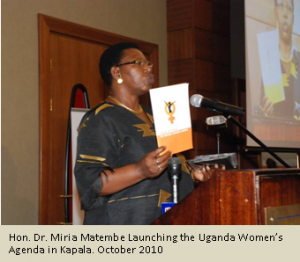After 19years of no party rule that saw modest efforts for women empowerment in Uganda, the country adopted a multiparty system of governance in 2005. Many political parties were formed in the run-up to the 2006 general elections. Like in other countries, multi party democracy was expected to open more opportunities for women to become engaged in decision making at different levels of political parties.
Political parties came up with manifestos and charters that fairly promised to handle women and gender issues, including promoting involvement of women in their decision making, as well as advancing women’s issues and concerns.
But how far are the political parties in Uganda implementing these commitments to including women and handling gender issues in their party agendas? Forum for Women in Democracy (FOWODE) commissioned a study in 2007 to analyse gender issues in political party agendas in Uganda. The study titled “Dancing to the tunes of Democracy: Women and political party agendas” found that despite the modest commitments to women and gender issues by all leading political parties, they have not done enough to ensure effective women representation in their structures and gender mainstreaming.
“Most political parties through the structures, processes and practices do not promote gender equity and equality and as such are discriminatory to women hence the need for more gender sensitivity and strategic interventions so that multi party democracy indeed benefits women,” the report reads in part.
 The study notes that women’s issues and commitments in political parties were “were lost in the mainstream”. “There is need for engagement with political parties to ensure that gender commitments have clear indicators, are thoroughly followed, and resources- human, time and financial are allocated to the fulfillment of these concerns,” the study recommends.
The study notes that women’s issues and commitments in political parties were “were lost in the mainstream”. “There is need for engagement with political parties to ensure that gender commitments have clear indicators, are thoroughly followed, and resources- human, time and financial are allocated to the fulfillment of these concerns,” the study recommends.
According to the study report, although most the party manifestoes, constitutions and strategic plans have some commitments to women, they do not have clearly laid out procedures to ensure that the commitments are translated into improved lives of women.
The study report shows that all political parties fell short of the required 40% women representation in the party’s governance structures that most political parties had committed to. The study notes that Forum for Democratic Change (FDC) had only four (4) women on its 13member top organ (31%), Democratic Party (DP) had four (4) women on its 11 member top organ (36%) while the ruling National Resistance Movement (NRM) had only three (3) women on its 13 member top body (23%).
The study notes that the deputizing syndrome has continued in most political parties with women taking up position of deputy or vice. Also, most political parties lumped women together with other special interest groups, which limited their ability to effectively focus on addressing gender issues. It was also noted that most political parties preferred to field male candidates than female candidates as party flag bearers. For example out of a total 808 contestants on open Parliamentary seats in the 2006 elections, only 33 were women, which constitutes four (4%) of the electoral contestants.
Table1: Number of flag bearers fielded by each party in 2006 Parliamentary elections
| Party ticket | N0. candidates | Females | Female %age of party total | Female %age of national total |
| NRM | 214 | 12 | 5.6 | 36.4 |
| FDC | 138 | 5 | 3.6 | 15.2 |
| DP | 68 | 5 | 7.4 | 15.2 |
| UPC | 78 | 1 | 1.2 | 1.2 |
| CP | 5 | 1 | 20.0 | 3.0 |
| JEEMA | 6 | 1 | 16.0 | 3.0 |
| Independent | 290 | 8 | 2.7 | 24.2 |
| Other parties | 9 | – | – | – |
| Total | 808 | 33 | 4.1 |
The analysis was conducted through participatory methods, including interviews with some of the political party officials, men and women; review of relevant literature that included political party manifestoes, constitutions, and press reports. The analysis also benefited from information obtained from partner organizations and leading scholars which was analyzed qualitatively and quantitatively.
Betty Kamya, the only leader of a political party and Presidential candidate in 2011
It should be noted however that this study was done based on information that was available to the researcher as it was difficult to get all political party documents due to bureaucracy and suspicion in regard to accessing information from political parties. The fact that the study was done hardly two years after multiparty politics was reintroduced in Uganda did also present a limitation to the study. As such, some political parties do have official information records, while some respondents were very busy for interviews.
In spite of the shortcomings, FOWODE successfully conducted the study that has generated data and information on how to enhance the visibility of women in the still male dominated political parties; and identification and pursuit of strategic issues of interest to women within political parties as Uganda prepares for the 2011 elections.
The analysis quotes numerous see more on page 2 below
Pages: 1 2
